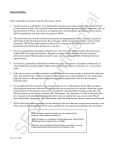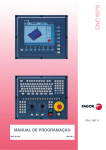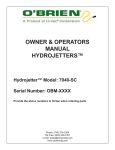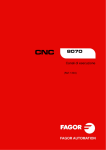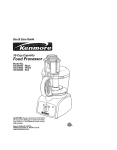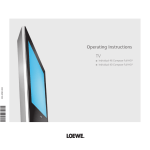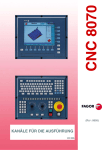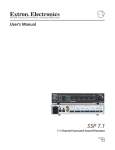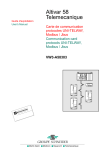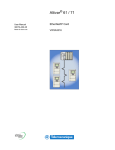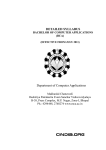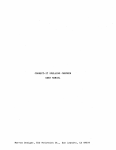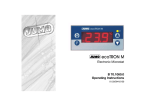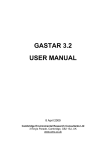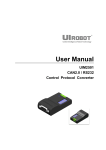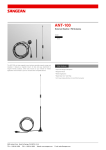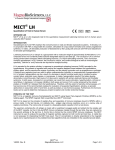Download CALM Common Assembly Language for Microprocessors user manual
Transcript
CALM - Common Assembly Language for Microprocessors
user manual
CALM
Common Assembly Language for Microprocessors
user manual
(c) Copyright Mai 1994
Patrick Fäh, La Colombière, CH-1783 Pensier, Suisse
1
CALM - Common Assembly Language for Microprocessors
user manual
Contents
CALM files............................................................................................................3
Ligne de commande............................................................................................4
Theory of operation.............................................................................................6
Cross reference list.............................................................................................6
Object format.......................................................................................................7
Pseudo-instructions............................................................................................9
Differences assembler - CALM standard........................................................10
Assembler errors...............................................................................................11
Inline with the CALM assembler......................................................................12
Generating .EXE programs with the CALM assembler.................................16
Using local labels..............................................................................................17
instructions optimally coded...........................................................................17
Extensions of the CALM assembler................................................................18
2
CALM - Common Assembly Language for Microprocessors
user manual
CALM files
You should have the following files on your system (assuming thatyou have an assembler for the
Z80 processor):
ASCALM.*
CALM assembler
MUFBIN.*
converts generated binary format (MUFOM)
Z80.PRO
processor module for the microprocessor Z800
TZ80.ASM
test file with Z80 instructions
ASCALMER.TXT lfile with errors (used by the assembler)
Minimal configuration :
Atari ST:
680x0, 256 KByte free, 1 floppy drive
PC/MS-DOS >= 2.x: iAPX86 comp. processor, 256 KByte, 1 floppy drive.
PC/MS-DOS:
only: set in CONFIG.SYS in minimum FILES=16.
DOS, TOS:
ASCALMER.TXT, *.PRO, and *.REF: actual PATH is used with SET
CALM=path, one can define another path.Command line
Ligne de commande
To assemble a CALM file, enter on your system: ASCALM <source file> [/switch]
The switches are optional. The following switches are available:
/Apath1;path2;
ASCALM defines additional paths for ASCALM, for the,files: ASCALMER.TXT,
*.PRO and *.REF. Example:
DOS, TOS:
PATH C:\ASCALM;C:\BIN;
command line: /AA:\PRODEF;
instruction:
.PROC Z80
tries to open:
1) Z80.PRO
2) A:\PRODEF\Z80.PRO
3) C:\ASCALM\Z80.PRO
4) C:\BIN\Z80.PRO
Same for ASCALMER.TXT and all *.REF. Limit length for all paths is 80
characters. With .PROC A:Z80 ASCALM tries only A:Z80.PRO.
fichier/B .MUF
generates a binary (MUFOM format)
fichier/C .ASC
generates file.ASC: all macros and .IF/.ELSE/.ENDIF are replaced. Not
possible if /E is used.
/Dnom=valeur
def. a symbol with name and value (+ or -, decimal).
fichier/E .ERR
copies all error messages also in this file.
/F
does not remove unused symboles loaded by .REF.
/Ipath1;path2;
Insert defines additional paths for .INS. Example:
command line: /IA:\SOURCE;B:\DEF\;C:\PROJET;
instruction:
.INS IO_PART
tries to open: 1) A:\SOURCE\IO_PART.ASM
2) B:\DEF\IO_PART.ASM
3) C:\PROJET\IO_PART.ASM
4) IO_PART.ASM
Limit length for all paths: 80 characters. With .INS B:IO_PART ASCALM tries
3
CALM - Common Assembly Language for Microprocessors
user manual
only B:IO_PART.ASM.
fichier/L .LST
generate a listing
/R
Read source files will not be modified
fichier/S .REF
contains all used symbols as assignments.
fichier/SA... .REF
as /S but add. are with ":"; also lists TRUE, etc.
fichier/Si... .REF
do not write some symbols in the .REF file: without values (i=0), addresses (1),
== (2), or .SYSCALL (3).
/V
Verify generates no binary (inhibit /B)
/W
Wait waits for every error line
fichier/X .XRF
generates the cross-ref file appended to the listing
If you do not use a switch, the assembler generates only a binary file. The switch /B is only
necessary when the binary .MUF should have another name or be located on another drive. The
source file is any file generated by PFED or any similar editor.
Each line should not exceed 128 characters in length and is terminated by <CR><LF>.
Let us test the assembler and its module by assembling the corresponding test file generating a
listing and a binary.
ASCALM TZ80/L
This command will take the source file TZ80.ASM and generate the binary TZ80.MUF and the
listing TZ80.LST. To assemble a file in drive B: and to copy the binary and the listing on drive A:
enter:
ASCALM B:TZ80 A:TZ80/L/B
ou
ASCALM B:TZ80 A:TZ80/L A:TZ80/B
4
CALM - Common Assembly Language for Microprocessors
user manual
Theory of operation
The assembler is started by the command: ASCALM <source>/L with the request of a listing. The
assembler opens the source file and creates the binary (.MUF) and listing (.LST) file. If any errors
are found in the program, the error line with the error indication is given in the listing, in the error
file (if /E), on the screen, and in the source file (if not /R).
MOVE
B,ALPHA
; source line of Z80 program
^ 31
When the assembler starts, he looks for the file ASCALMER.TXT. If this file is not found, the errors
are shown with numbers. Otherwise the errors are shown in text form:
MOVE
B,ALPHA
; source line of Z80 program
^ symbol value undefined
The following keys may be entered if a error message appears at the screen:
"D" don't wait after an error
"S" stop the assembly (always possible)
"W" wait after an error
If any fatal error occurs (file does not exist, disk full, etc.) the assembler halts and shows some
information on the screen (ASCALM returns 4 to the system, else 0). Do the necessary corrections
and restart the assembler again.
The I/O files like CON:, AUX:, etc., are supported.
To show the listing on the screen, and without binary, you must enter: ASCALM TZ80 CON:/L/V
Important: The assembler makes a copy of the source file to insert the error messages. Therefore,
make sure there is enough disk space! This copy (.AST) with the error messages will then replace
the original file. With the option /R, the assembler will not modify the source file(s). This copy is
also done for inserted files (.INS).
Characters in the file names: "0".."9","A".."Z","a".."z","_","?", "-",":","\",".".
Cross reference list
To obtain the cross reference list of a program, you must use the switch /X:
ASCALM TZ80 B:TZ80/X
The assembler generates the file B:TZ80.XRF. Be careful of the size of this file, if you use a lot of
symbols in your program. The cross reference list is written (added if /L) to the listing TZ80.LST.
The temporary file TZ80.XRF is deleted.
5
CALM - Common Assembly Language for Microprocessors
user manual
Object format
The CALM assembler always generates object files with the extension .MUF. This binary format is
an ASCII format. Only absolute formats are generated. To convert the MUFOM format to for
example .COM you must use the program MUFBIN:
MUFBIN <objet.MUF>/options
MUFBIN limits the binary output length to actually 64 Kbytes (exception: no limitation with /B/N,
/H/N, /I/U, /M/U (/N: when data is consecutive).
he following options determine the output format (no default):
/B
.BIN binary, also /N or /Y must be indicated
i/E
.EXE for PC/MS-DOS, i (1..3) defines the memory structure
/H
.BIN hexadécimal, ASCII, il faut aussi indiquer /N ou /Y
/I
. HEX , fIntel's hex format
/M ou i/M .FRS, Motorola's S format (default: S0, S3 and S7; 1/M: S0, S1 and S9; 2/M: S0, S2
and S8; 3/M: S0, S3 and S7).
/T
.TOS, for Atari ST
With the options /B and /H you can add a header in the front. These files are composed of a
header of 256 bytes followed by the image of the binary. The header contains the following
information:
offset.
content [determined by]
0
load address [lowest .LOC with generated code]
2
length
4
start address [.START start]
[code]
The byte order for the three 16 bit numbers is low-high. If you don't want to add the header,
enter /N. The generated binary file is compatible to the .COM file, if the start and the load address
is hexadecimal 100. With /Y you can automatically add the header.
A
shifts the object by the specified value (hexadecimal_value/A).
/D
data size (used with /E; hexadecimal_value/D).
/F
performs an AND-operation between the indicated filter value and the addresses
(hexadecimal_value/F).
/J
hh/J: val. for undef. byt., per def.: 00/J. Use FF/J for EPROM.
/L
fixes the number of data bytes in a line with /H, /I and /M (range: 1 to 250; default
values: 39, 32, 32; value/L). The command /H 0/L will generate no <CR><LF>.
/O
changes the name of the output file (filename/O).
/S
stack size (used with /E; hexadecimal_value/S).
/U
undefined areas are not filled (used with /I or /M).
/V
shows all inform. (except data) contained in the MUFOM file.
6
CALM - Common Assembly Language for Microprocessors
/W
user manual
word swap: exchanges LSB and MSB in a 16-bit word.
Examples:
- change the output file name (generating Intel format): MUFBIN input/I output/O I/O files (like
CON:, AUX:) are possible for output.
- the 2 add. ranges 16'0 to 16'FFF and 16'F000 to 16'FFFF have to be placed in one physical 8
KByte EPROM. The command MUFBIN input/B/N 1FFF/F will gen. an 8 KByte output bin. file,
which can be used directly to prog. the EPROM. Else the output file would be 64 KByte long.
- shift the object by the specified value: MUFBIN input/I 200/A If the file has been ass. with a
.LOC 16'0, MUFBIN will gen. An Intel hex comp. output file which starts with 16'200. The
object code itself is not mod. If also /F has been spec., the filter operation is performed first.
Pseudo-instructions
Only the following pseudo-instructions are supported by the CALM Assembler: .ALIGN, .APC,
.ASCII, .ASCIZ, .ASCIZE, .BASE, .BLK.n, .CHAP, .DATA.n, .ELSE, .END, .ENDIF, .ENDLIST,
.ENDMACRO, .ERROR, .EVEN, .EXITMACRO, .FILL.n, .IF, .INS, .LAYOUT, .LAYOUTMACRO,
.LIST, .LISTIF, .LOC, .LOCALMACRO, .MACRO, .MESSAGE, .ODD, .PAGE, .PROC,
.PROCSET, .PROCVAL, .RANGE, .REF, .START, .STRING, .SYSCALL, .TITLE, .8, .16 und .32 .
Remarks to some pseudo-instructions (se also UPDATESE.*):
.ASCIZE
- corresponds to .ASCIZ followed by .EVEN (generates 0).
.IF/.ELSE/.ENDIF
- IF <expression> is true, when <expression> <> zero.
- IF..ENDIF may be nested up to 32 times.
- IF and the correspondant ENDIF must be in the same file.
- IF..ELSE..ELSE..ENDIF is possible.
.INS
- with .INS file,READONLY the inserted file is only read. Error
messages will not appear in this file. They are reported in the
main file (if possible) or the error file (if /E).
- default file extension: .ASM.
- only one nested level is allowed.
.LAYOUT
- With .LAYOUT the following parameters are possible:
HEX (addresses and data in hexadecimal representation)
LENGTH n
(n lines per listing page, n=0: infinite)
Example:
.LAYOUT HEX, LENGTH 60 ; values of the assembler
- Following values are always fixed:
HEX (OCT is not possible)
WIDTH 127 (line length)
TAB 8
(one tabulator corresponds to 8 spaces)
7
CALM - Common Assembly Language for Microprocessors
user manual
.LIST/.ENDLIST
- LIST <expression> is true when <expression> <> zero.
- LIST..ENDLIST may be nested up to 255 times.
- LIST and the correspondant ENDLIST must be in the same file.
.LISTIF <expression>
- .LISTIF shows all .IF/.ELSE/.ENDIF pseudo-instr. in the listing.
- .LISTIF is active when <expression> is <> zero or <expression> is not present.
.REF fichier
- file.REF is a text file and may contain assignments, .SYSCALLs, and comments. The
file is read once and is never modified.
- the PATH is respected.
.SYSCALL.n nom (n = 8, 16 ou 32)
- defines a special macro: .MACRO name; .n name%1; .ENDMACRO. The SYSCALLs
are allowed in .REF files. Example: INTDOS = 16'CD21;
.SYSCALL.16 INT; call: INT DOS; generates: .16 INTDOS.
The following pseudo-instructions are not supported: .ENDTEXT,.EXPORT, .IMPORT, .TEXT
Differences assembler - CALM standard
The CALM Assembler does not support the full CALM Standard. The differences:
symbole:
- name: 32 (local labels: 29) signs are significant. characters: "A".."Z", "a".."z", "_", "?"
and "0".."9" (<> 1. position). Accent letters are converted to upper case letters.
- value: 32 bit with sign.
expression:
- word length: 32 bit with sign.
the maximum number of open operations is 15.
- shift amplitude (.SR., .SL. und .ASR.): shift amplitude is limited to 8 bits (-256..+255). A
negative amplitude inverts the shift direction.
général:
- maximum length of a input assembly line is 127.
- the APC has a length of 32 bits.
- some pseudo-instructions are not supported.
- the \-commands are not supported.
- .PROC: only one times allowed
8
CALM - Common Assembly Language for Microprocessors
user manual
Assembler errors
Refer to ASCALMER.TXT. ASCALMEE.TXT contains the error messages in english. You may copy
this file in ASCALMER.TXT.
Quelques remarques concernant les erreurs fatales:
101 .PROC error
(Something in the file.PRO is not correct. Try again with the /D switch to localise the
instr., which causes this error.)
102 .PROC
too long (Not enough memory)
103 cannot load file
(The assembler can't find the specified file in .PROC or .INS.
104 cannot open source
(The assembler can't find the source file.)
105 error to create file
(The assembler can't create the *.MUF or/and *.LST file.)
106 no .PROC
The assembler tries to assemble an instruction, but no .PROC has been loaded:
put .PROC in the front of your file.)
107 cannot reset source
(The assembler resets the source before the second pass. Check your system.)
108 bad .PROC version
(Your file.PRO has a bad version and can't work correctly with the assembler.)
109 command line is empty
(You must give the file to assemble directly on the command line.)
110 new symbol in 2nd pass
(A new symbol appeared in the 2nd pass; if you are working in a network
environnement try again; localise the line with the /D switch.)
111 over-/underflow in .PRO
(Something wrong with the interpretation of the .PRO file.)
112 symbol table overflow
113 end of file: missing .ENDMACRO
114 macro buffer overflow
115 too many nested .INS
116 stopped
(The assembler has been stopped by the key "S".)
117 .PROC/.REF: must precede code generation
(Put .PROC and .REF in the beginning of the source; after .TITLE.)
9
CALM - Common Assembly Language for Microprocessors
user manual
Inline with the CALM assembler
TurboPascal and Pascal/MT+ feature the INLINE statements as a very convenient way of inserting
machine code instructions directly into the program text. Refer to the corresponding Pascal user
manuals for more details about INLINE syntax and limitations.
The CALM assembler can be used to generate the corresponding machine code. The following
example shows the steps to generate INLINE statements for the iAPX86 (PC/MS-DOS) and the
Z80 (CP/M-80).
The function HEXNIBBLE tests and converts any character to an integer if the character is a valid
hex number ('0'..'9','A'..'F','a'..'f'):
FUNCTION HEXNIBBLE(VAR H:INTEGER):BOOLEAN;
{in: ActCh, out: H (value), HEXNIBBLE (true or false)}
VAR C:CHAR;
BEGIN
C:=UpCase(ActCh); HEXNIBBLE:=TRUE;
IF (C >= '0') AND (C <= '9')
THEN BEGIN
H:=ORD(C)-ORD('0');
END
ELSE
IF (C >= 'A') AND (C <= 'F')
THEN BEGIN
H:=ORD(C)-ORD('A')+10;
END
ELSE BEGIN
H:=0; HEXNIBBLE:=FALSE;
END;
END;
Now you must convert the Pascal procedure to assembler. Thefollowing two pages show the
iAPX86 and Z80 versions of the functionHEXNIBBLE. For this, firstly you write the assembler
instructions innormal assembler form in an assembler source file and assemble thisfile with a
listing. Then, you delete the Pascal source lines betweenBEGIN and END in the function
HEXNIBBLE. You insert the assemblerlisting file after BEGIN. You delete all dummy assembler
listing linesand also the addresses (4 characters in front of each line). Now youput the generated
listing bytes in the INLINE form: begin withINLINE(, add $ and / between the listing bytes, etc. Put
theinstructions in Pascal comment form (with (* and *)). Finally, youmust replace all variable
references by their correct name (RESULT,HEX).
It is important to know exactly the internal representation of thedifferent data types. Knowing this,
you can significantly improve theassembler version (speed, code size). For example, the boolean
valuehere is 1 for TRUE and 0 for FALSE. Also you must know how to accessthe different
variables. The correspondent Pascal user manuals giveyou more information.
To test the Pascal/Assembler performance, the following smallprogram has been used:
10
CALM - Common Assembly Language for Microprocessors
user manual
PROGRAM THEX;
VAR {teste la version en assembleur et en Pascal de HEXNIBBLE}
ACTCH: CHAR;
RESULT: BOOLEAN;
I, VALUE: INTEGER;
{$I P_HEX} { P_HEX: Pascal, A_HEX: assembleur }
BEGIN
WRITELN('START');
FOR I:=1 TO 1000 DO {1000 x}
BEGIN
FOR ACTCH:=' ' TO '~' DO {95 caractères}
RESULT:=HEXNIBBLE(VALUE);
END;
WRITELN('END');
END.
The following results have been obtained:
code size seconds (for THEX)
Pascal version
192 octets
26,3
Assembler version
80 octets
20,6
Difference
-58 %
-22 %
(XT-compatible, clock 4.77 MHz, TurboPascal 3.0 for PC-DOS)
These numbers should give you a general idea. Very often, theassembler version is significantly
faster (2..4) than the Pascalversion. In addition, the code size reduction is always impressive.The
iAPX86 (PC/MS-DOS) version (Listing):
Version iAPX86 (PC/MS-DOS), Listing:
0000
0000
2710
00002710
2710
2710
0000
00000000
0000
0000
8A861027
0004
31C9
0006
2C30
0008
7211
000A
3C09
000C
760A
000E
2C07
0010
3C0A
0012
7207
0014
3C0F
0016
7703
0018
88C5
001A
41
001B
88AE1027
001F
888E1027
.TITLE
.PROC
.LOC
RESULT:
HEX:
.LOC
HEXNIBBLE:
MOVE.8
XOR.16
SUB.8
JUMP,LO
COMP.8
JUMP,LS
SUB.8
COMP.8
JUMP,LO
COMP.8
JUMP,HI
OK$:
MOVE.8
INC.16
END$:
MOVE.8
MOVE.8
HEXNIBBLE
IAPX86
10000
; address > 8 bit:
; assembler gets 16 bit
0
[SS]+{BP}+RESULT,AL
CX,CX
; CL = FALSE (=0),
#"0",AL ; CH = VALUE
END$
#9,AL
OK$
#"A"-"0"-10,AL
#10,AL
END$
#15,AL
END$
AL,CH
; nibble
CX
; CL = TRUE (=1)
CH,[SS]+{BP}+RESULT
CL,[SS]+{BP}+HEX
11
CALM - Common Assembly Language for Microprocessors
user manual
Procédure:
FUNCTION HEXNIBBLE(VAR H:INTEGER):BOOLEAN;
{in: ActCh, out: H (value), HEXNIBBLE (true or false)}
VAR RESULT:INTEGER; HEX:BOOLEAN;
BEGIN
RESULT:=ORD(UpCase(ActCh));
INLINE(
$8A/$86/RESULT/ (*
MOVE.8 [SS]+{BP}+RESULT,AL
*)
$31/$C9/
(*
XOR.16 CX,CX;CL=FALSE (=0), CH=VALUE*)
$2C/$30/
(*
SUB.8
#"0",AL
*)
$72/$11/
(*
JUMP,LO END$
*)
$3C/$09/
(*
COMP.8 #9,AL
*)
$76/$0A/
(*
JUMP,LS OK$
*)
$2C/$07/
(*
SUB.8
#"A"-"0"-10,AL
*)
$3C/$0A/
(*
COMP.8 #10,AL
*)
$72/$07/
(*
JUMP,LO END$
*)
$3C/$0F/
(*
COMP.8 #15,AL
*)
$77/$03/
(*
JUMP,HI END$
*)
$88/$C5/
(*OK$:
MOVE.8 AL,CH
; nibble
*)
$41/
(*
INC.16 CX
; CL = TRUE (=1)
*)
$88/$AE/RESULT/ (*END$:
MOVE.8 CH,[SS]+{BP}+RESULT
*)
$88/$8E/HEX);
(*
MOVE.8 CL,[SS]+{BP}+HEX
*)
HEXNIBBLE:=HEX; H:=RESULT;
END;
Version Z80 (CP/M-80), Listing:
0000
0000
2710
00002710
2710
2710
0000
00000000
0000
0000
3A1027
0003
010000
0006
D630
0008
3810
000A
FE0A
000C
380A
000E
D607
0010
FE0A
0012
3806
0014
FE10
0016
3002
0018
47
0019
0C
001A
78
001B
321027
001E
79
001F
321027
.TITLE
.PROC
.LOC
HEXNIBBLE
Z80
10000
RESULT:
HEX:
.LOC
HEXNIBBLE:
MOVE
MOVE
SUB
JUMP,LO
COMP
JUMP,LO
SUB
COMP
JUMP,LO
COMP
JUMP,HS
OK$:
MOVE
INC
END$:
MOVE
MOVE
MOVE
MOVE
0
RESULT,A
#0,BC
; C = FALSE (=0),
#"0",A ; B = VALUE
R8^END$
#9+1,A
R8^OK$
#"A"-"0"-10,A
#10,A
R8^END$
#15+1,A
R8^END$
A,B
; nibble value
C
; TRUE (=1)
B,A
A,RESULT
C,A
A,HEX
12
CALM - Common Assembly Language for Microprocessors
user manual
Procédure:
FUNCTION HEXNIBBLE(VAR H:INTEGER):BOOLEAN;
{in: ActCh, out: H (value), HEXNIBBLE (true or false)}
VAR RESULT:INTEGER; HEX:BOOLEAN;
BEGIN
RESULT:=ORD(UpCase(ActCh));
INLINE(
$3A/RESULT/
(*
MOVE
RESULT,A
*)
$01/$00/$00/
(*
MOVE
#0,BC ;C=FALSE (=0), B=VALUE*)
$D6/$30/
(*
SUB
#"0",A
*)
$38/$10/
(*
JUMP,LO R8^END$
*)
$FE/$0A/
(*
COMP
#9+1,A
*)
$38/$0A/
(*
JUMP,LO R8^OK$
*)
$D6/$07/
(*
SUB
#"A"-"0"-10,A
*)
$FE/$0A/
(*
COMP
#10,A
*)
$38/$06/
(*
JUMP,LO R8^END$
*)
$FE/$10/
(*
COMP
#15+1,A
*)
$30/$02/
(*
JUMP,HS R8^END$
*)
$47/
(*OK$:
MOVE
A,B
; nibble value
*)
$0C/
(*
INC
C
; TRUE (=1)
*)
$78/
(*END$:
MOVE
B,A
*)
$32/RESULT/
(*
MOVE
A,RESULT
*)
$79/
(*
MOVE
C,A
*)
$32/HEX);
(*
MOVE
A,HEX
*)
HEXNIBBLE:=HEX; H:=RESULT;
END;
13
CALM - Common Assembly Language for Microprocessors
user manual
Generating .EXE programs with the CALM assembler
The PC/MS-DOS operating system uses two types of programs: .COM and.EXE. The .COM
programs are residues from CP/M-80. Program, data andstack segments reside in a total memory
space of 64K. Programexecution starts at 16'100. Therefore, all four segment registers ofthe
iAPX86, CS, DS, ES and SS, have the same value, and they all pointto the beginning of a 64 K
segment. However, when a .COM program isstarted, all the free memory is used - not only the
64K.
The .EXE programs are more complicated. They have a header, whichcontains information on the
program length, the starting values of theprogram counter (CS:IP) and the stack pointer (SS:SP),
etc. A .EXEprogram may have separate program, data and stack segments. So thelimit of 64 K is
no longer valid. An .EXE program only occupies thememory space needed.
It is possible to generate .EXE programs with the CALM assembler.To do this, the programmer
must know where the segments (program,data, stack) are and how to initialize and access them.
However, thecode segment length is limited to 64 K (without tricks). The stack anddata segments
may also have 64 K each (but any length with somemanipulations).
Writing .EXE programs with the CALM assembler needs some care. Itis not possible to load a
segment register (DS or ES) with a constant(for example with a label via AX), because the program
would belocated at another (unknown) address. Relocation is done by the user.He correctly
initializes the segment registers and uses them as "basepointers". Note, that this programming
style is possible with anyassembler. Many .EXE files in the PC/MS-DOS system do not
needrelocation before starting up (because they have no relocation entriesin their .EXE header).
To generate .EXE programs, you need the CALM assembler (ASCALM andMUFBIN) and the
processor module iAPX86 (or iAPX186, iAPX286). TheCALM assembler is also used to
generate .COM programs. In .COMprograms, you will never modify the segment registers. The
programwill start with .LOC 16'100. In .EXE programs, you MUST initialize thedata segment.
Before execution, the system initializes the segments CS(code) and SS (stack). The segments DS
and ES (data) point to the PSP(program segment prefix). The program code always starts in
theassembler source file with .LOC 0. In addition, you can specify anystart address with .START.
You can assemble the source file andconvert the generated object with MUFBIN file i/E to the
specific.EXE binary file. However, the stack and data sizes are not known andthe user must enter
these values. MUFBIN supports actually three .EXEmemory structures. These three possibilities
depends on yourprogramming choice. You will find three corresponding
examples(TESTEXE1/2/3.ASM) joined to the module iAPX86. In these examples youwill also find
more explanations.
The command line to start MUFBIN is:
MUFBIN input_file{.MUF} i/E {stack_size/S} {data_size/D}Text within braces are optional. /i
chooses one of the three .EXEmemory structures. /S and /D fix the stack and data sizes
(ifrequired). Example (case 2):
MUFBIN TESTEXE2 2/E 80/S 104/D
14
CALM - Common Assembly Language for Microprocessors
user manual
Using local labels
Local labels (for example LOOP$) are not really different fromglobal labels (for example START).
However, local labels can not befound in the cross reference list because their significance is
onlylocal. In addition, local labels are valid (may be used) only betweentwo global labels. For these
reasons, local labels are preferably usedin subroutines where they are the marker points for loops,
conditionsand exit. Example:
TEXTHL:
PRINTC$ =
2
; local assignment
PUSH
HL
; in HL ^.ASCIZ
LOOP$:
MOVE
{HL},A
OR
A,A
JUMP,EQ R8^END$
; <NULL> reached ?
PUSH
HL
MOVE
A,E
MOVE
#PRINTC$,C
; show character on the screen
PUSH
HL
CALL
BDOS
POP
HL
INC
HL
JUMP
LOOP$
END$:
POP
HL
RET
LOOP$ and END$ may also be used in other subroutines. Therefore,one must not always invent
new names like LOOP1, LOOP2, etc. Inaddition, only TEXTHL (the name and the entry point of the
subroutine)appears in the cross reference list.JUMP instructions optimally coded
There exist two addressing possibilities for jump instructions inmany 8 bit microprocessors:
instructions optimally coded
There exist two addressing possibilities for jump instructions inmany 8 bit microprocessors:
1) JUMP R8^étiquette (adr. relatif, APC-128..APC+127, 2 octets)
2) JUMP 16^étiquette (adr. absolu, 0..16'FFFF, 3 octets)
If the address specifiers R8^ and 16^ are not present, the CALMassembler chooses automatically
either case 1) or 2). But when is case 1) generated?
Case 1) has two advantages compared with case 2):relative addressing (address independent)
and shorter machine code (2instead of 3 bytes).
Let us consider the following situation:
...
BEFORE:
...
JUMP BEFORE
...
JUMP AFTER
...
AFTER:
; (a)
; (b)
15
CALM - Common Assembly Language for Microprocessors
user manual
We see, that JUMP BEFORE (a) jumps to a label, which is definedbefore the jump instruction,
and that JUMP AFTER (b) jumps to alabel which is defined after the jump instruction.
In the case of (a), the CALM assembler may generate the relativeaddressing. For this to happen,
the offset, from the APC of the JUMPBEFORE instruction to the label BEFORE, must be less than
129. If theoffset is greater, the CALM assembler will choose the absoluteaddressing.
The CALM assembler chooses in (b) always the absolute addressing,even when AFTER is less
than 127 Bytes from (b) away. This is becauseof the following reason: The assembler reads a
source program twice(two passes) to generate the machine program. In the first pass, theCALM
assembler meets in (b) the unknown label AFTER. As the CALMassembler does not know the
value, the worst case is taken (that meansthe label AFTER is far away) and the CALM assembler
generates anabsolute jump instruction (3 bytes). The first pass is only used toevaluate the correct
addresses. In the second pass, the CALM assemblermeets in (b) again the label AFTER, now
known. In some cases, theoffset is really less than 128, or in other words, a relative 8
bitaddressing would have been possible. But now this is impossible: Ifthe CALM assembler were to
choose here a relative jump instruction (2bytes), then all the following addresses would be moved
by one byte!Therefore, the CALM assembler must choose in (b) the same instructionas in the first
pass, that means, an absolute jump instruction.
To force case 1) or case 2), one must insert the address specifierR8^ or 16^. The same thing is
also valid for other instructionsoptimally coded.Extensions of the CALM assembler
Extensions of the CALM assembler
The CALM assembler is a macro assembler, that is, also macros aretreated.
Multiple definitions in assignments and labels are allowed if thesymbols have the same name and
the same value (CR = 13; CR = 16'D).
Local assignments (A$ = 10) are allowed and have the samepossibilities as the local symbols
(A$:).
Multiple assignments (A == 10) are possible and the value may bemodified (A == 20). Corresponds
to SET on other assemblers. Usualassignments (A = 10) can not be mixed with multiple
assignments (A == 20).
The base number may be indicated by letters:
16'nnnn H'nnnn X'nnnn H'AF
10'nnnn D'nnnn
D'100
8'nnnn O'nnnn Q'nnnn Q'377
2'nnnn B'nnnn
B'110
End of document.
16
















